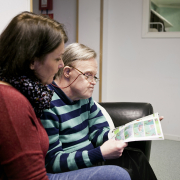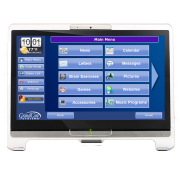Disability Care Staffing Solutions: How Enabling Technologies Are Solving the Provider Shortage
While many disability service providers struggle with staffing shortages, some are finding solutions to mitigate the problem, cutting costs and increasing independence and outcomes for their residents using enabling technologies.
We recently hosted an engaging discussion with three leaders from organizations utilizing enabling technologies such as GrandCare during our webinar, Combatting DSP Staffing Shortages with Assistive Technology. Our guest speakers included Brian Hart, the COO of LADD and the CEO of ShiftAbility, and Heather Weitz and Christine Gilbertson of Wisconsin-based provider, Opportunity Inc.
LADD is an agency in Ohio that, four years ago, wanted to use technology-enabled supports to change the way they delivered services. As they looked to solve a staff shortage, they devised a Smart Living model. “The Smart Living model is not just a piece of technology or software, it’s a new way of delivering services using technology first, value-added supports, a way we assess staff, cultural methodology of inclusive services, and a whole bunch of different models.” Out of that bore ShiftAbility, a consulting arm, as a way to share how to implement these models for other organizations.
A smart home uses technology like GrandCare touchscreens, sensors, health devices and med dispensers that work as a support system and other home technologies like smart refrigerators and stoves.
“There’s never going to be enough people to provide the support. If you want to provide more supports, you have to do it a different way.” Brian Hart.
Opportunity Inc. is a nonprofit organization in Wisconsin that provides supports in AFH (adult family home) settings and community supportive living settings. Heather and Christina work in the community supportive living program.
“GrandCare has given us a way to actually implement self-sufficiency. Instead of just having staff come in, teach them something and 20 minutes after we walk about the door they completely forget everything that we went through, with GrandCare we’re able to upload videos and add reminders. This has been a huge way that GrandCare has helped us get to the independent living skills and maintain those independent living skills,” said Christina.
A GrandCare system is a remote monitoring and remote support platform on a stationary 17-inch touchscreen that can be set on a countertop or mounted on a wall. The touchscreen can deliver cognitive assists in the form of reminders for ADLs, medication, calendar appointments and much more. It can connect with motion sensors in the home and health devices such as pulse oximeters. Notification rules, simple if-then statements, can be customized for each individual and their support team. The touchscreen provides secure video calls, plus the system includes games, live radio and other entertainment features.
“It helps with staffing as well. We have some clients in their own homes that just need us to go check that they took their medications. Now they can mark off that they did it, and if we need a visual we can video chat instead of having somebody go over. Some of them like that because they want their privacy,” said Heather.
Christina added that many of their high functioning clients use a button on the touchscreen to check in for the night, which sends a notification to the staff that they’re safe at home, and that allows the staff to focus on the people who they need to be physically present for.
“They like that they feel more independent. Instead of coming to us all the time they can go on to their own GrandCare system and look for their schedules, see if they have doctor appointments or when the staff might be coming, and what they’re going to be doing with staff that day.” Heather Weitz
What’s the ROI on Assistive Technology?
The first LADD smart home was part of a two-year study by Xavier University. Researchers set out to measure “occupational performance” (the ability to do everyday tasks without help), resident satisfaction, and the cost of care in the new smart home setting. The results were remarkable. LADD was able to safely reduce direct caregiving hours by an astonishing 75%. This had a profound impact on the cost of care. Prior to GrandCare and remote monitoring technologies, the cost of supporting these individuals was $5,260 per week. Supportive technologies slashed the support costs by over 50% to only $2,607 per week.
“The technology ROI is less than nine months. It’s getting even faster now as we get more efficient,” said Brian. “Each year we’re able to do more with the same amount of resources.”
Learn More
Want to learn more about the GrandCare technology, choosing residents, setting up tech, staff training and funding? You can view the recording of our webinar.
“The big issues we have in our field are staffing, funding and transportation. We can solve for a lot of staffing and funding using technology.” Brian Hart
Have questions or would like to see a free demo? Contact us.











